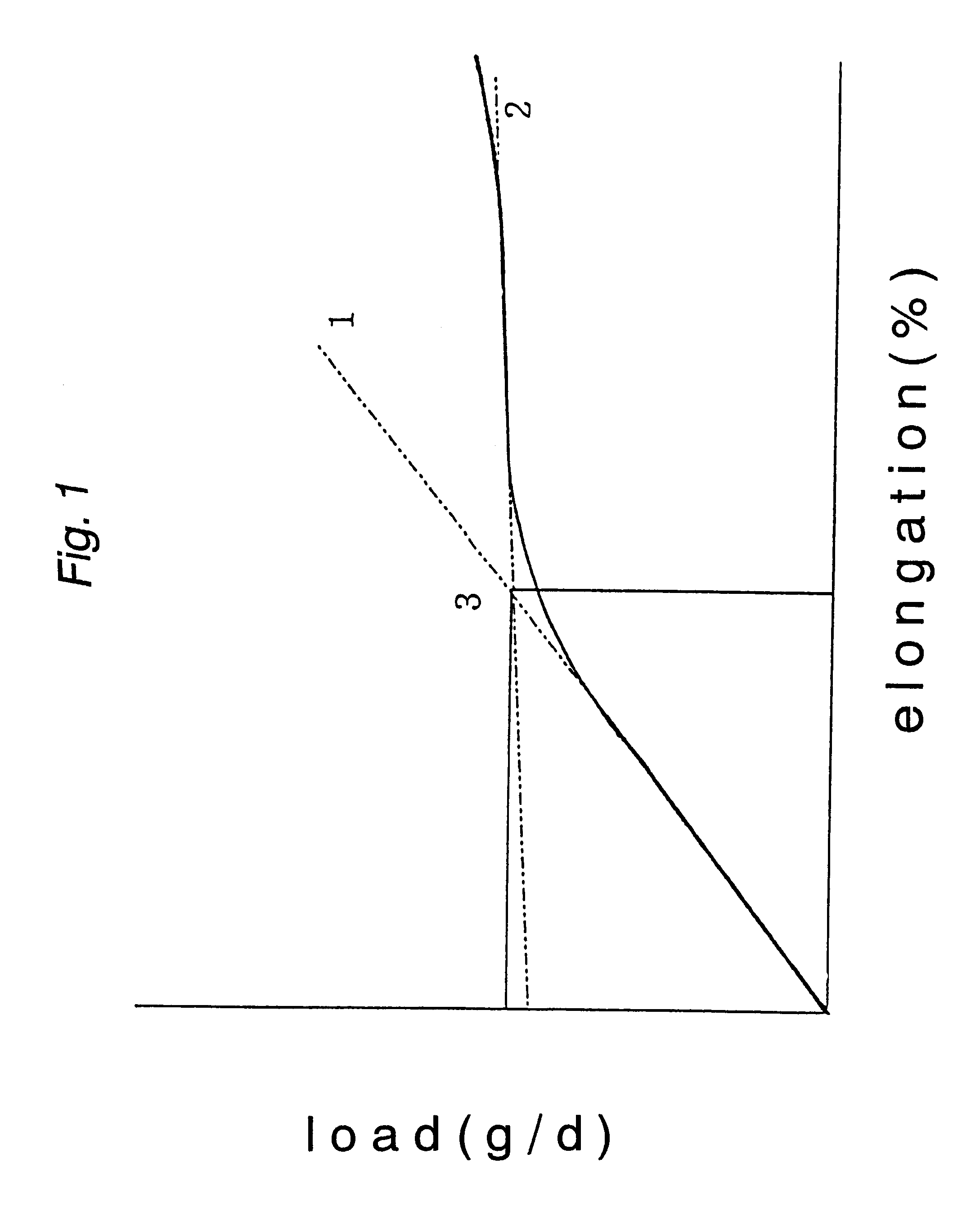Polyester fiber and process for preparing the same
a technology applied in the field of polyester fiber and process for preparing the same, can solve the problems of uneven shrinkage, increased cost, and considerable shrinkage, and achieve the effects of low crystal orientation, high crystallinity, and low crystal siz
- Summary
- Abstract
- Description
- Claims
- Application Information
AI Technical Summary
Benefits of technology
Problems solved by technology
Method used
Image
Examples
examples 1 and 2
, Comparative Examples 1 to 4
255 denier 30 filament POY was obtained by melt spinning polyethylene terephthalate (IV=0.68) and employing a take-off rate of 3100 m / minute. Without drawing, this raw yarn was treated by passage under a tension of 1.5.times.10.sup.-2 g / d and at a rate of 350 m / minute through a 350.degree. C. atmosphere in a non-contact heater (length 2 m) and 25% shrinkage effected, and 320 denier shrink-treated yarn obtained (Example 1). As a further set of treatment conditions, there was used a yarn processor with two independent non-contact heaters and, at a processing rate of 400 m / minute, 340 denier shrink-treated yarn (Example 2) was obtained by effecting 20% shrinkage at a first stage heater temperature of 320.degree. C., a heater length of 2 m and a tension of 1.8.times.10.sup.-2 g / d, and then effecting 10% shrinkage with the temperature of the second stage heater at 320.degree. C., at a heater length of 1 m and a tension of 0.7.times.10.sup.-2 g / d, to give a to...
example 4
Using theshrunk yarn from Example 3, twisting (plying) was performed with a 280 denier 14 filament drawn yarn at 200 T / M (S twist). With this yarn as the centre yarn, and 150 denier 48 filament false-twist textured yarn as the yarn for the front and back ground structures, a knitted spacer fabric was produced using a double-face circular knitting machine. This knitted spacer fabric as treated for 5 minutes at 180.degree. C. in a hot forced-air dryer, and then dyed for 30 minutes at 130.degree. C. using disperse dye.
In the same way as in Example 3, the fabric obtained did not readily exhibit permanent yielding in terms of repeated compression loading, and the sheet as a whole had good resilience and showed good cushioning properties.
When the shrunk yarn portion of the central yarn was analysed after removal from the knitted material in Example 4, it satisfied the property values (B) which are a necessary condition in the present invention.
examples 5 and 6
, Comparative Examples 7 and 8
Using the knitted spacer fabric grey cloths from Examples 3 and 4, and from Comparative Examples 5 and 6, shaping was carried out for 1 minute at 180.degree. C. using a hemispherical moulding machine. The products were respectively taken as Example 5 (using the grey cloth from Example 3), Example 6 (using the grey cloth from Example 4), Comparative Example 7 (using the grey cloth from Comparative Example 5) and Comparative Example 8 (using the grey cloth from Comparative Example 6). The shaping property, shape retention, resilience and washing durability were as follows. For each assessed item, the products of the present invention were better than the comparative examples.
Now, the properties of the yarn removed from the shaped articles obtained in Example 5, Example 6, Comparative Example 7 and Comparative Example 8 were as follows. Example 5 and Example 6 satisfied the property values (B) which are a requisite in the present invention.
PUM
| Property | Measurement | Unit |
|---|---|---|
| Temperature | aaaaa | aaaaa |
| Fraction | aaaaa | aaaaa |
| Fraction | aaaaa | aaaaa |
Abstract
Description
Claims
Application Information
 Login to View More
Login to View More - R&D
- Intellectual Property
- Life Sciences
- Materials
- Tech Scout
- Unparalleled Data Quality
- Higher Quality Content
- 60% Fewer Hallucinations
Browse by: Latest US Patents, China's latest patents, Technical Efficacy Thesaurus, Application Domain, Technology Topic, Popular Technical Reports.
© 2025 PatSnap. All rights reserved.Legal|Privacy policy|Modern Slavery Act Transparency Statement|Sitemap|About US| Contact US: help@patsnap.com



